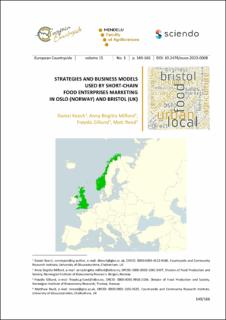| dc.contributor.author | Keech, Daniel | |
| dc.contributor.author | Milford, Anna Birgitte | |
| dc.contributor.author | Gillund, Frøydis | |
| dc.contributor.author | Reed, Matt | |
| dc.date.accessioned | 2023-09-27T11:27:31Z | |
| dc.date.available | 2023-09-27T11:27:31Z | |
| dc.date.created | 2023-05-04T12:31:08Z | |
| dc.date.issued | 2023-04-02 | |
| dc.identifier.citation | European Countryside. 2023, 15 (1), 149-166. | en_US |
| dc.identifier.issn | 1803-8417 | |
| dc.identifier.uri | https://hdl.handle.net/11250/3092373 | |
| dc.description.abstract | Short food supply chains (SFSCs) are associated with a range of contested, place-based attributes which contrast with the characteristics of complex, global and corporate chains. This article avoids such oppositional binaries by focusing on SFSCs serving two European cities, namely Oslo (Norway) and Bristol (UK). It reviews cities as a particular kind of market within which to secure custom, by presenting qualitative data from a study of SFSCs in these two cities to examine marketing barriers and opportunities encountered. Distinctive urban contexts, such as the density of consumers and presence of food-related infrastructures, can influence the marketing strategies and sales channels chosen by food enterprises. Difficulties are faced by both food producers and the sales channels through which they come to market, especially in relation to financial viability, price competition and efficiency. Our analysis, as well as highlighting connections and divergences between Oslo and Bristol, emphasises the role of these cities in providing diverse food market niches. Alongside global chains, functioning SFSCs help to reflect the history of Oslo and Bristol as trading cities with diverse populations and reveal enterprise adaptability and innovation as market demand shifts. | en_US |
| dc.language.iso | eng | en_US |
| dc.publisher | Sciendo | en_US |
| dc.rights | Attribution-NonCommercial-NoDerivatives 4.0 Internasjonal | * |
| dc.rights.uri | http://creativecommons.org/licenses/by-nc-nd/4.0/deed.no | * |
| dc.title | Strategies and Business Models used by Short-Chain Food Enterprises Marketing in Oslo (Norway) and Bristol (UK) | en_US |
| dc.type | Peer reviewed | en_US |
| dc.type | Journal article | en_US |
| dc.description.version | publishedVersion | en_US |
| dc.rights.holder | © 2023 Daniel Keech et al., published by Sciendo | en_US |
| dc.source.pagenumber | 149-166 | en_US |
| dc.source.volume | 15 | en_US |
| dc.source.journal | European Countryside | en_US |
| dc.source.issue | 1 | en_US |
| dc.identifier.doi | 10.2478/euco-2023-0008 | |
| dc.identifier.cristin | 2145441 | |
| dc.relation.project | Norges forskningsråd: 294604 | en_US |
| cristin.ispublished | true | |
| cristin.fulltext | original | |
| cristin.fulltext | original | |
| cristin.qualitycode | 1 | |

